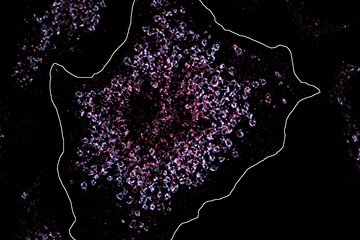Without scars
Research team discovers crucial regenerative mechanism
It is the old dream of medicine: a cut finger that grows back completely - or tissue that regenerates completely and without scarring after an injury. Mankind is still a long way from reaching this point, but researchers from Giessen and Bad Nauheim have now discovered an important mechanism by which scar formation or tissue regeneration is regulated. The research results could be groundbreaking for the therapy of injuries or even cardiovascular diseases such as myocardial infarction.

Tissue injuries in humans typically lead to the formation of scars that are accompanied by hardening. These so-called fibrotic processes are among the main causes of various human diseases, most notably those affecting the cardiopulmonary system. For example, injury to the heart caused by a heart attack or by chronic high blood pressure leads to scarring that negatively affects cardiac performance. The reason for this change lies in certain cell types - the so-called connective tissue cells (fibroblasts) or the endothelial cells of our blood vessels. These cell types change into so-called myofibroblasts, which control the formation of the scar.
Unlike mammals, some vertebrates are able to almost completely regenerate damaged or lost tissue even after severe injury, that is, to return the lost tissue to its original healthy state. These species include many fish, most notably zebrafish. These animals can functionally restore lost fins, scales, but also the central nervous system and even internal organs including the heart after injury within a few days to weeks. Myofibroblast formation is very limited in these cases. In order to develop new therapeutic approaches for regenerative medicine, scientists are intensively researching this mechanism.
Interleukin-11 receptor alpha suppresses scar formation
A research team from Justus Liebig University Giessen and the Max Planck Institute for Heart and Lung Research in Bad Nauheim, led by Sven Reischauer from Justus Liebig University, has now been able to show that the suppression of scar formation in zebrafish is coupled to the signaling pathway mediated by the protein interleukin-11 receptor alpha. Thus, the researchers found that zebrafish in which the interleukin-11 signaling pathway was knocked down using the CRISPR technique formed scars just like humans and other mammals. "These animals did not show complete regeneration of injured tissue," explained Srinivas Allanki, first author of the study and a doctoral student in Reischauer's group. Detailed studies revealed an unexpected change in the cells' behavior. Instead of activating a genetic program that reprograms fibroblasts and endothelial cells to support regeneration, they now form myofibroblasts in injured tissue - the very cells that are thought to be responsible for fibrosis in humans. This phenomenon could even be experimentally reversed in certain cells, so that these cells once again participate in regeneration.
"Zebrafish with interleukin-11 signaling turned off respond at the cellular level basically like we humans do to injury and activate a fibrotic gene program. This is the first time we have identified a mechanism that simultaneously protects against scarring and promotes regeneration across tissue boundaries in a single well-defined signaling pathway," said Sven Reischauer. This means that science now has "a foot in the door." In a next step, the researchers now want to investigate whether and how human cells could also be induced to activate such a cell regeneration program. With a deeper understanding of the different responses of tissues to injury, it may not only be possible to develop new antifibrotic therapies, but also new approaches to growing tissues in the test tube for therapeutic applications.
JLU/MPI-HLR












